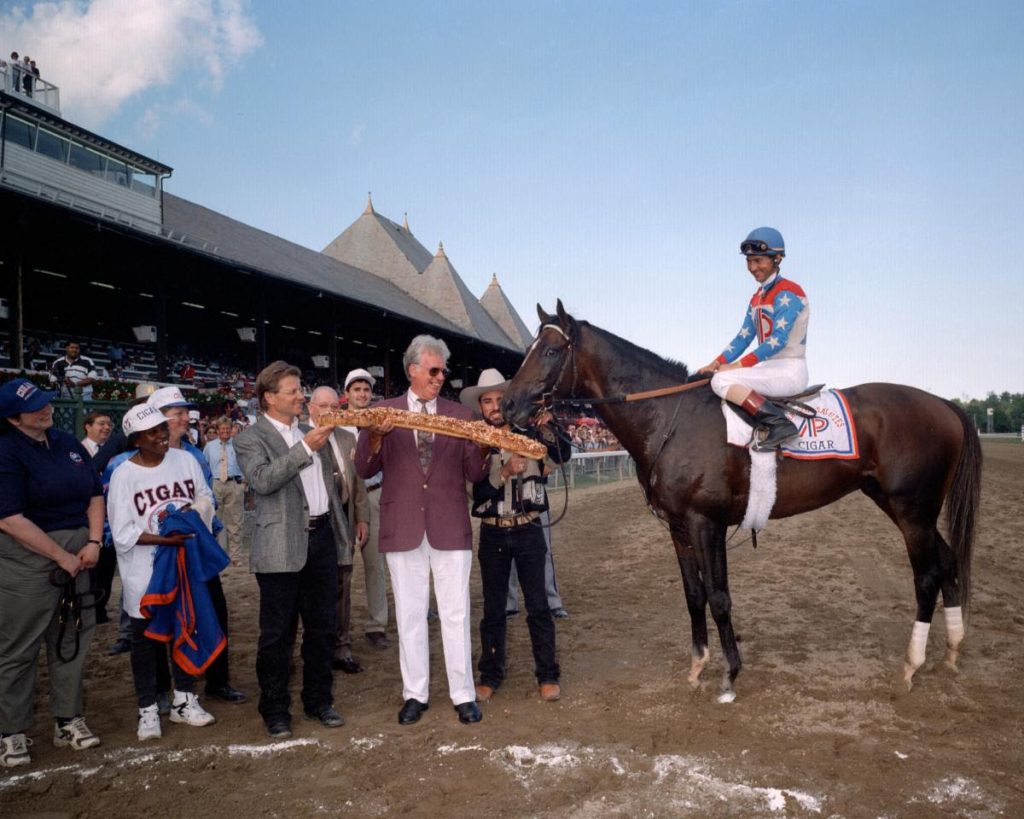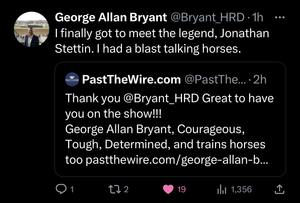
By Karen M. Johnson
OZONE PARK, N.Y. – If the measure of success in horse racing is judged solely on statistics, then trainer Bill Mott, an icon on the New York Racing Association circuit for more than three decades, has earned legendary status.
Mott, 66, is on the cusp of saddling 5,000 career winners in North America; a milestone only matched in North American racing by six others according to Equibase. As of March 3, Mott has won 4,984 races from 25,418 starts in North America.
Other numbers epitomize Mott’s amazing career, including 45, which was his age when he became the youngest trainer to be inducted into the National Museum of Racing and Hall of Fame in 1998. Another figure, 16, represents the number of consecutive races won by Cigar, a horse whose campaign he so skillfully managed.But numbers alone fail to encapsulate the enormous breadth of Mott’s career and his impending milestone, nor does it factor the immense respect he has garnered from his contemporaries.
Mott could have won a fraction of the races and still would have earned the praise of his peers. In racetrack parlance, designating someone a “horseman” bestows high praise. Mott’s upcoming milestone certainly puts him in a rarified group, but it’s his genius behind the scenes that has truly defined him and earned him the distinction of being a bonafide horseman.
One of Mott’s longtime rivals, fellow Hall of Famer Shug McGaughey, recalled a conversation he had with Mott on the day of last year’s Runhappy Travers at Saratoga Race Course. McGaughey saddled Code of Honor in the Grade 1, $1.25 million race and was in search of his fourth win in the “Mid-Summer Derby,” while Mott was represented by the post-time favorite and Belmont Stakes runner-up Tacitus.
“We were in the racing office and I said to Bill, ‘I’m tired of running against you,'” recalled McGaughey, who a little while later was accepting congratulations for winning the Travers from Mott, who finished second.
“Bill will be the first one to congratulate you and when he won the [Kentucky] Derby last year, I went to congratulate him in his barn,” McGaughey said. “We’ve been competing together since we were in Kentucky, when we were both younger guys, and he came to New York about the same time I did. It’s always been a friendly competition with us. I think he’s an excellent, excellent horseman and caretaker. He places his horses great. I have nothing but the highest of praise for him.”
Mott, who won his first Kentucky Derby in 2019 with Country House after the colt was elevated to first place upon the disqualification of Maximum Security for interference, has been on the big stage for a long time. But it took steady and hard work on small circuits for the three-time Eclipse Award-winning trainer to reach this pinnacle of success. The first winner he saddled came at the age of 15, at the now-defunct Park Jefferson in his native South Dakota with My Assets, a mare who was purchased for $320 by his father, a veterinarian.
One of Mott’s earliest mentors was legendary trainer Jack Van Berg, for whom he galloped horses before becoming one of his assistants. While an employee of Van Berg’s, Mott owned one of the horses in the Hall of Famer’s barn, Old Thunder. It was during that time Mott met future Hall of Fame jockey Jerry Bailey, who rode Old Thunder to victory in a race at Arlington Park in 1976.
Bailey, who was aboard Cigar for 15 of his 16 consecutive wins, including a tour de force in the 1995 Breeders’ Cup Classic at Belmont Park, said it should never be underestimated how difficult it is for a trainer to keep a horse at his peak for such a long time.
“One of things that made Cigar great was that he was able to be great for a long period of time,” said Bailey, who retired from riding in 2006 and is now a commentator for NBC Sports. “To win so many races in a row during the course of a couple years . . . I mean it’s really hard to keep a horse at his peak for any length of time, much less during the course of one-and-a-half, to close to two years. I think that may go unnoticed by a lot of people.
“Not only did Bill figure out that although Cigar was bred on both sides [of his pedigree] for grass, he was actually a dirt horse, he was also able to get Cigar to his peak when he needed to and kept him at that peak for a long time. You’ll see horses really good for three races, but then they can’t hold that form. It’s really hard to keep a horse’s best performances coming, race after race after race. There is an art to it.”
Bailey said Mott’s ability to intuit at any given moment what his horses are telling him – through their training and demeanor – has been instrumental to the trainer’s success.
“The horse comes first with Bill,” Bailey said. “With trainers, there is obviously a lot of things and moving parts they have to deal with – paperwork, help, logistics, communications with owners. But Bill is a guy if you can’t find him, look in a stall, because that’s where he will be. He is so hands-on.
“There’s a lot of ways to be successful training and not one way works,” Bailey added. “But he is of the Allen Jerkens mold. Bill made almost every decision that I can remember relating to a horse’s welfare – his training, his schedule – based upon how the horse was acting at that moment. A lot of guys have programs and the horse is going to do that on Monday, Tuesday and Wednesday, regardless. Not necessarily so with Bill. If the horse was acting right and if he thought the horse was up to what he wanted to do, then OK, let’s go with the program. But it was a total feel thing for Bill.”
The first of what is now 10 Breeders’ Cup victories for Mott came in the 1987 Turf at Hollywood Park with Theatrical. An Eclipse Award winner – the first of six individual champions trained by Mott – Theatrical was owned by Bert and Diana Firestone, who gave the trainer one of his first big breaks by bringing him to New York from Kentucky to train their horses in 1987.
A couple of years later, Hall of Fame rider Mike Smith was looking to make his mark in New York, and the rider’s prior association and success with Mott at tracks such as Arlington Park, Canterbury Park, and Churchill Downs paved the way for the two men to share together many important victories on the NYRA circuit.
While Smith later moved his tack to Southern California, he remains a very familiar presence at NYRA tracks, flying in to ride in major races on a regular basis, and it was the Mott-trained Drosselmeyer who gave the jockey and trainer their first win in the final leg of the Triple Crown, the Belmont Stakes, in 2010. The following year, the WinStar Farm-owned Drosselmeyer and Smith sailed to a late-charging victory in the Breeders’ Cup Classic.
Like Bailey, Smith has observed over the years just how in tune Mott is with his horses, and said when the trainer tells him that a horse is ready to fire big, he knows those words are to be taken seriously.
“I remember when I got the opportunity to ride Drosselmeyer in the Belmont Stakes and Bill told me, ‘I have him pretty good today. I think he’s going to run big today,'” Smith said. “The horse had some foot problems, but Bill was confident that he had the horse as good as he could get him for the Belmont. And sure enough, he ran huge.
“For the Classic, Bill told me, ‘I’ve never had him this good.’ Of course he won the Classic and it was such a great race. He came from way out of it, came sloping down the middle of the racetrack and hit the wire with plenty left. The thing about Bill, is when he says he has a horse right, 99.9 percent of the time they are going to [perform well]. It’s not a guessing game with him.”
While the trainer is razor-focused at his barn and runs a carefully monitored operation, Smith said there are moments of levity to be found in Mott’s shed row, including a particular case with 1990 Jim Dandy-winner Chief Honcho, whom he rode for Mott.
“It had rained at Saratoga and there were those big puddles they have in the barn area. And there was this one that was always there, near Bill’s barn,” Smith recalled. “One day, Chief Honcho, with me on him, took off straight to that big puddle, and started rolling around in it. Bill yelled, ‘Why did you let him do that!’ I said, ‘I didn’t let him do that, I couldn’t stop him from it!’ Bill made me go and clean him up. Man, I had to get the tack off and help clean him up. Let me tell you, it was a mess.
“About a week later, Bill was riding him, and there was that puddle again. I didn’t say a word. Bill was talking away and he got too close to that puddle and Chief Honcho dropped down and started rolling around. I said, ‘Bill, man, you’re going to have to clean that horse up right now.'”
Elliott Walden, WinStar Farm’s president/CEO and racing manager, and a former trainer, shared a tidbit about Mott. When Walden was training and had Victory Gallop in the barn, he broke his ankle while playing in a pickup basketball game and was unable to saddle the colt when he won the 1998 Belmont Stakes. Mott was deputized for him, and Walden is fond of reminding him that he actually has saddled two Belmont winners.
Articulate and thoughtful in his answers when giving interviews to the media, there’s still the sense that Mott would much rather be in a stall with a horse than holding court with the press. And Walden said it’s precisely that type of adoration for his horses has help him reach elite status in the sport’s history.
“Bill is kind of old-school in the fact that he prefers to be with the horses. His attention to detail when it comes to the horse is incredible,” Walden said. “You’ll see him walk around his stalls and put his hands on each horse in the morning. You’ll see him tighten a screw-eye where the feed tub goes. You’ll see him shake up the hay in the hay net, if it’s not shaken properly. He’ll pick a foot up and pick their feet if he needs to. He loves to be with his horses.
“Everybody that is successful has a characteristic that separates them apart from the pack, and I would say Bill’s is his ability to work with the horse and to understand the uniqueness in each horse and to bring out the best in each horse.”
Via NYRA Press Office Press Release
Photo: Coglianese Photos NYRA



